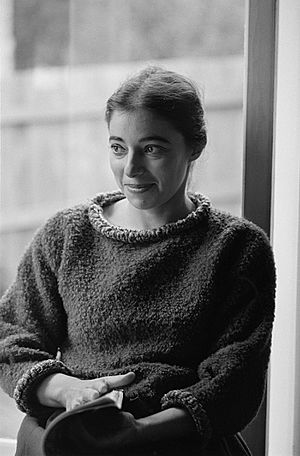Mirka Mora facts for kids
Quick facts for kids
Mirka Mora
|
|
|---|---|

Mora in 1961
|
|
| Born |
Mirka Madeleine Zelik
18 March 1928 |
| Died | 27 August 2018 (aged 90) |
| Nationality | French, Australian |
| Education | Self-taught |
| Known for | Painting, Sculpture, Mosaics |
| Awards | Officier de l'Ordre des Arts et des Lettres |
Mirka Madeleine Mora (born March 18, 1928 – died August 27, 2018) was a famous artist from France who became a very important part of Australian art. She created many different types of art, including drawings, paintings, sculptures, and mosaics. Mirka Mora was also a well-known cultural figure in Melbourne, Australia.
Contents
Mirka's Early Life in France
Mirka Mora was born in Paris, France, on March 18, 1928. Her father, Leon Zelik, was from Lithuania, and her mother, Celia Gelbein, was from Romania. Both of her parents were Jewish.
During World War II, when Mirka was 14, she was arrested in Paris in 1942. This was part of a terrible event called the Vel' d'Hiv Roundup. Luckily, her father managed to get her released from a camp before she and her mother were sent to Auschwitz. From 1942 to 1945, Mirka and her family stayed safe by hiding in the forests of France.
After the war, when she was 17, Mirka met Georges Mora, who had been a resistance fighter. They got married in 1947.
Moving to Australia
After surviving the difficult war years, Mirka Mora and her husband decided to move to Australia in 1951. They chose Melbourne because Mirka had read about it in a French novel. The book described Melbourne as a place where people could make their fortune.
When they arrived, Mirka and Georges quickly became important people in Melbourne's art and culture scene. Mirka started as a dressmaker while also making her own art. Georges became a very successful art dealer. In 1967, he opened the Tolarno Galleries, which became one of Melbourne's top art galleries.
Cafés and Art Hubs
The Mora family also owned and ran three popular cafés in Melbourne. These places became famous meeting spots for artists and creative people.
- The Mirka Café opened in 1954.
- The Café Balzac followed.
- The Tolarno opened in 1966 in St Kilda. Mirka herself decorated the Tolarno with her amazing art, including murals on the walls and windows.
Mirka's son, Philippe, remembers that his parents often helped artists by providing food at their home and in their restaurants.
Friends in the Art World
The Mora family had many friends who were famous Australian artists and writers. These included Charles Blackman, Fred Williams, John Perceval, and Arthur Boyd.
They were also very close with John and Sunday Reed, who were important supporters of the arts. The Moras often spent weekends at the Reeds' famous home, "Heide" (now the Heide Museum of Modern Art), and at their beach house.
Mirka and Georges had three sons:
- Philippe Mora, who became a film director.
- William Mora, who became an art dealer.
- Tiriel Mora, who became an actor.
Philippe described their childhood as "culturally privileged." Mirka and Georges later separated.
Sharing Her Artistic Skills
For many years, Mirka Mora taught art workshops. She shared her special way of teaching painting, soft sculpture, and mosaics with countless Australians. She also traveled to France, the USA, and Japan to lead her workshops.
Later Years and Legacy
Mirka Mora lived and worked in several studios in Melbourne. She even appeared on Australian TV shows in 2012 and 2013. In 2016, she worked with the Australian fashion company Gorman to create a clothing collection based on her artworks. Her beautiful murals can still be seen on the walls of the Tolarno restaurant in St Kilda.
In 2016, a lost mural by Mirka was found on a wall in an East Melbourne bar, which used to be the Café Balzac.
Mirka Mora passed away at her home in Melbourne on August 27, 2018, at the age of 90. Her life was celebrated with a special State Memorial, attended by over 1200 people. She was the first female artist in Victoria to receive such an honor.
Awards and Recognition
In 2002, Mirka Mora was given a special award by the French Minister of Culture and Communication. She was made an Officier de l'Ordre des Arts et des Lettres, which is a high honor for artists. A lane in St Kilda, called Mirka Lane, was also named after her.
Exhibiting Her Art
Mirka Mora's first public art show was in 1954, where she displayed three paintings of circus clowns. Throughout her career, she had more than 35 solo exhibitions. Her art was shown in many galleries, including the Heide Museum of Modern Art and the Tolarno Galleries.
A major exhibition celebrating 50 years of her work, titled Mirka Mora: where angels fear to tread: 50 years of art 1948–1998, was held at the Heide Museum of Art from 1999 to 2000. Just before she passed away, her charcoal drawings were featured at the Melbourne Art Fair in 2018.
Where to See Her Art
Mirka Mora's artworks are held in many important collections, so people can continue to enjoy them.
- National Gallery of Victoria, Melbourne
- National Gallery of Australia, Canberra
- Ballarat Fine Art Gallery
- Heide Museum of Modern Art, Melbourne
- Ararat Regional Gallery
- Myer Collection
- Peter MacCallum Cancer Institute, Melbourne
- National Australia Bank, Melbourne
- Council for Adult Education, Melbourne
- Federation Tapestry, Melbourne Museum
- St Kilda Pier Entrance Pavilion
- National Theatre Trust, Sydney
- Cosmos Bookshop, Melbourne
- Flinders Street Station, Melbourne
- Adelaide Festival Centre
- Perth Festival
- Ayr Community Library, Queensland
- Burdekin Library and Theatre, Sydney
- Tolarno Restaurant, Melbourne
- Malthouse Theatres Southbank Phantom Figures Panel Collection
- Many private collections around the world
See also
- Art of Australia
- List of Australian artists

